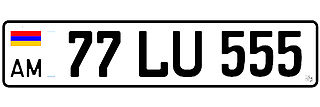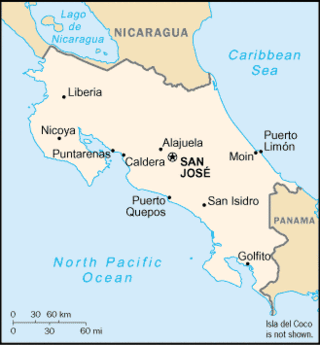
A vehicle registration plate, also known as a number plate or license plate or licence plate, is a metal or plastic plate attached to a motor vehicle or trailer for official identification purposes. All countries require registration plates for road vehicles such as cars, trucks, and motorcycles. Whether they are required for other vehicles, such as bicycles, boats, or tractors, may vary by jurisdiction. The registration identifier is a numeric or alphanumeric ID that uniquely identifies the vehicle or vehicle owner within the issuing region's vehicle register. In some countries, the identifier is unique within the entire country, while in others it is unique within a state or province. Whether the identifier is associated with a vehicle or a person also varies by issuing agency. There are also electronic license plates.

In Japan, the national government issues vehicle registration plates for motor vehicles through the Ministry of Land, Infrastructure, Transport and Tourism Land Transportation Offices nationwide. However, the local municipality rather than the national government registers certain vehicles with small engine displacements.

Vehicles registered in Slovakia were generally assigned to one of the districts (okres) and from 1997 until 2022, the license plate coding generally consisted of seven characters and takes the form XX-NNNLL, where XX was a two letter code corresponding to the district, NNN was a three digit number and LL were two additional letters.
The most common format for vehicle registration plates in Romania consists of black letters on white background in the format CC 12 ABC, where CC is a two letter county code, 12 is a two digit group, and ABC is a three letter group. For Bucharest, the format is B 12 ABC or B 123 ABC, where B is code for Bucharest city, 12 and 123 is a two or three digit group, and ABC is a three letter group. The left side of the plate bears a blue vertical strip displaying the 12 stars of the European Union and the country code of Romania (RO). Between 1992-2007 the band featured the Romanian flag instead of the 12 stars. All lettering comes from the Latin alphabet.
Austrian car number plates are mandatory vehicle registration plates displaying the registration mark of motor vehicles in Austria. They are used to verify street legality, proof of a valid liability insurance and to identify and recognise the vehicle.

Vehicle license plates in the Philippines are issued and regulated by the Land Transportation Office, a government agency under the Department of Transportation (DOTr).
Vehicle registration plates of Poland indicate the region of registration of the vehicle given the number plate.

In the United States, vehicle registration plates, known as license plates, are issued by a department of motor vehicles, an agency of the state or territorial government, or in the case of the District of Columbia, the district government. Some Native American tribes also issue plates. The U.S. federal government issues plates only for its own vehicle fleet and for vehicles owned by foreign diplomats. Until the 1980s, diplomatic plates were issued by the state in which the consulate or embassy was located.
A vehicle registration plate, also known as a number plate, license plate or licence plate, is a metal or plastic plate or plates attached to a motor vehicle or trailer for official identification purposes. The registration identifier is a numeric or alphanumeric code that uniquely identifies the vehicle within the issuing authority's database. In Europe most countries have adopted a format for registration plates that satisfies the requirements in the Vienna Convention on Road Traffic, which states that cross-border vehicles must display a distinguishing code for the country of registration on the rear of the vehicle. This sign may be an oval sticker placed separately from the registration plate, or may be incorporated into the plate. When the distinguishing sign is incorporated into the registration plate, it must also appear on the front plate of the vehicle, and may be supplemented with the flag or emblem of the national state, or the emblem of the regional economic integration organisation to which the country belongs. An example of such format is the common EU format, with the EU flag above the country code issued in EU member states.
In the United States, the appearance of license plates is frequently chosen to contain symbols, colors, or slogans associated with the issuing jurisdiction, which are the 50 U.S. states, the District of Columbia, the five inhabited U.S. territories, and Native American tribes, each of which independently registers motor vehicles. Regular-issue license plates for passenger vehicles typically have six or seven characters, with vanity plates having up to eight characters in a few states.

The U.S. state of New York was the first to require its residents to register their motor vehicles, in 1901. Registrants provided their own license plates for display, featuring their initials until 1903 and numbers thereafter, until the state began to issue plates in 1910.
Vehicle registration plates of Estonia are divided into 18 categories, the most common of these (A1) is composed of three numbers and three letters. Most registration plate types have black letters on a white background, and the plates are the same size and length as other European plates. Previously the first of the three letters indicated the region of Estonia in which the car was registered; however, as of 2013, this is no longer the case. The third digit from the numbers indicated states when the car is due an inspection. It can be inspected up to 2 months after that digit. The registration plates are printed on an aluminium sheet with minimum thickness of 1 mm and must fulfil the requirements of ISO 7591:1982. All plates are issued with the blue European Union identification label, except types A9 and B2.
Aruba requires its residents to register their motor vehicles and display vehicle registration plates. The island is one of the last jurisdictions in the world to continue issuing new plates each year rather than showing re-validation through stickers or other documentation.

In Taiwan, all motor vehicles are required to register and display its vehicle registration plates. The plates are issued and managed by the Ministry of Transportation and Communications (MoTC). Vehicle registration numbers in Taiwan contain letters of the Latin alphabet, Arabic numerals and dashes (–); some special types also contain Chinese characters and used Agency FB typeface or typeface resembles Garage Gothic typeface like several American countries, Nigeria and Liberia for alphanumeric.

Since the end of the year 2000 Paraguay has required its residents to register their motor vehicles with the National Register of Vehicles and to display vehicle registration plates; this system has replaced the former one whereby plates were issued by municipal authorities, who also kept local registers.

Vehicle registration plates of Armenia have black characters on a rectangular white background. They are composed of two or three numbers, two letters in the middle, and two other numbers. At the left side is located the international code "AM" with an oval car plaque and, sometimes, the national flag. Starting from 6 August 2014 a new design of license plates was implemented. The license plates have a national flag on the left side, a security hologram and a machinery readable Data Matrix Code.
Vehicle registration plates are the alphanumeric plates used to display the registration mark of a vehicle, and have existed in the United Kingdom since 1904. It is compulsory for motor vehicles used on public roads to display vehicle registration plates, with the exception of vehicles of the reigning monarch used on official business.
Tajik vehicle registration plates are registration plates for vehicles registered in the country.

Costa Rica is a Central American nation that boasts of a noteworthy safety record on crime as compared to its neighbors in the region. It is one of few nations that have abolished their nation's armed forces. Having had a stable past, this country has been successful in developing its economy. However, since 2000 there has been a significant rise in criminal activity. Increase in domestic illegal activity, such as theft, homicide, and organised crime, has overwhelmed the local population. Sebastian Huhn reports that, "In a public opinion poll in 2011, 45 percent of Costa Rican respondents said that crime and insecurity were the country’s biggest social problems." As a consequence of the overall societal changes, domestic-driven crime has been increasing in the environment that extends beyond traditional settings. Illegal activity, including distribution of weapons has been most commonly witnessed during the sporting events by 'barras' or fan clubs. Crime in Costa Rica, thus, is not only due to domestic crime groups but also transnational criminal organisations.

Little is known about the early history of Haitian license plates. Keith Marvin thought that the earliest plates were from the early 1930s, but older plates have since been found and at least one plate from 1923 exists. Early plates were marked with Rd'H,, HA., RH, or Haïti at various times. The Haitian coat of arms appeared on the plates from 1998 to 2002, the country flag was shown on the 2002 - 2005 plates, and since 2006 the background has shown a map of the country. With the last update on the design, the slogan La perle des Antilles was added at the bottom of the plate in white colour.





























